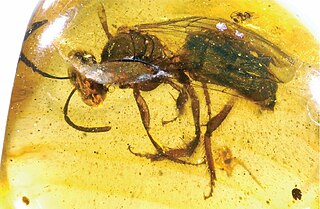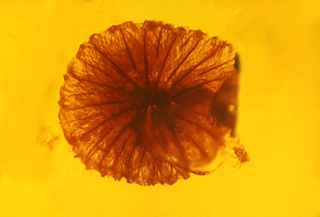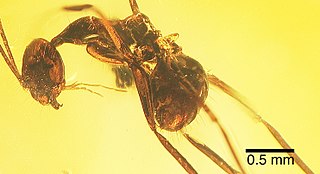
Triatoma dominicana is an extinct species of assassin bug in the subfamily Triatominae, the kissing bugs known from early Miocene Burdigalian stage Dominican amber deposits on the island of Hispaniola.
Neocorynura electra is an extinct species of sweat bee in the Halictidae genus Neocorynura.

Oligochlora is an extinct genus of sweat bee in the Halictidae subfamily Halictinae. The genus currently contains six species, all of which are known from the early Miocene Burdigalian stage Dominican amber deposits on the island of Hispaniola.
Augochlora leptoloba is a species of sweat bee in the genus Augochlora and the extinct monotypic subgenus Electraugochlora.

Leptofoenus pittfieldae is an extinct species of wasp in the family Pteromalidae. It is known from early Miocene Burdigalian stage Dominican amber deposits on the island of Hispaniola. The species is known from a single 8.8 millimetres (0.35 in) male specimen excavated from the La Toca mine group northeast of Santiago de los Caballeros in 2008 and deposited in the Insect Fossil Collection at the University of Kansas Natural History Museum in Lawrence, Kansas, where it was studied and described by Dr. Michael S. Engel. The species name pittfieldae honors Ms. Morgan Pittfield, niece of the specimen donor.

Termitaradus mitnicki is an extinct species of true bug in the family Termitaphididae known only from early Miocene Burdigalian stage Dominican amber deposits on the island of Hispaniola.
Palaeoraphe is an extinct genus of palms, represented by one species, Palaeoraphe dominicana from early Miocene Burdigalian stage Dominican amber deposits on the island of Hispaniola, in the modern-day Dominican Republic.
Roystonea palaea is an extinct species of palm known from fossil flowers found in the early Miocene Burdigalian stage Dominican amber deposits on the island of Hispaniola. The species is known from a single staminate flower and a single pistillate flower both preserved in the same piece of amber. The amber specimen bearing the holotype and paratype is currently deposited in the collections of the Oregon State University in Corvallis, Oregon, as number "Sd–9–101", where it was studied and described by George Poinar. Poinar published his 2002 type description for R. palaea in the Botanical Journal of the Linnean Society, Volume 139. The species' second name is taken from the Greek word palaios meaning "ancient". The amber specimen bearing the flowers was excavated from the La Toca mine northeast of Santiago de los Caballeros, Dominican Republic.

Electromyrmococcus is an extinct genus of mealybug in the Pseudococcidae subfamily Rhizoecinae. The genus currently contains three species, all from the early Miocene, Burdigalian stage, Dominican amber deposits on the island of Hispaniola.
Protosialis casca is an extinct species of alderfly in the Sialidae subfamily Sialinae. The species is solely known from the early Miocene, Burdigalian stage, Dominican amber deposits on the island of Hispaniola. Protosialis casca is one of only two known alderfly species present in the West Indies, the only other species is the living Protosialis bifasciata native to Cuba.

Coprinites is an extinct monotypic genus of gilled fungus in the Agaricales family Agaricaceae. At present it contains the single species Coprinites dominicana.

Lutzomyia adiketis is an extinct species of sandfly in the moth fly subfamily Phlebotominae. L. adiketis is a vector of the extinct Paleoleishmania neotropicum and both species are solely known from early Miocene Burdigalian stage Dominican amber deposits on the island of Hispaniola.
Pintomyia falcaorum is an extinct species of sandfly in the moth fly subfamily Phlebotominae. P. falcaorum is solely known from early Miocene Burdigalian stage Dominican amber deposits on the island of Hispaniola.
Tainosia is an extinct monotypic genus of planthopper in the Nogodinidae subfamily Nogodininae and at present, it contains the single species Tainosia quisqueyae. The genus is solely known from the early Miocene, Burdigalian stage, Dominican amber deposits on the island of Hispaniola.

Dryinus grimaldii is an extinct species of wasp in the dryinid genus Dryinus. The species is solely known from the early Miocene, Burdigalian stage, Dominican amber deposits on the island of Hispaniola.

Dryinus rasnitsyni is an extinct species of wasp in the dryinid genus Dryinus. The species is solely known from the early Miocene, Burdigalian stage, Dominican amber deposits on the island of Hispaniola.
Termitaradus dominicanus is an extinct species of termite bug in the family Termitaphididae known from a Miocene fossil found on Hispaniola. T. dominicanus is the third species in the genus Termitaradus to have been described from fossils found in Dominican amber after Termitaradus avitinquilinus and Termitaradus mitnicki.

Zigrasimecia is an extinct genus of ants which existed in the Cretaceous period approximately 98 million years ago. The first specimens were collected from Burmese amber in Kachin State, 100 kilometres (62 mi) west of Myitkyina town in Myanmar. In 2013, palaeoentomologists Phillip Barden and David Grimaldi published a paper describing and naming Zigrasimecia tonsora. They described a dealate female with unusual features, notably the highly specialized mandibles. Other features include large ocelli, short scapes, 12 antennomeres, small eyes, and a clypeal margin that has a row of peg-like denticles. The genus Zigrasimecia was originally incertae sedis within Formicidae until a second species, Zigrasimecia ferox, was described in 2014, leading to its placement in the subfamily Sphecomyrminae. Later, it was considered to belong to the distinct subfamily Zigrasimeciinae.

Zatania electra is an extinct species of ant in the subfamily Formicinae known from three possibly Miocene fossils found on Hispaniola. Z. electra is one of several Zatania species found in the Greater Antilles.

Enischnomyia is an extinct genus of bat fly in the family Streblidae. At the time of its description the new genus comprised a single species, Enischnomyia stegosoma, known from a single Miocene fossil found on Hispaniola. E. stegosoma was the first fossil streblid bat fly described from a fossil, and the only member of the subfamily Nycterophiliinae described from Hispaniola. The species is host for the plasmodiid Vetufebrus ovatus preserved in its salivary glands and midgut.












